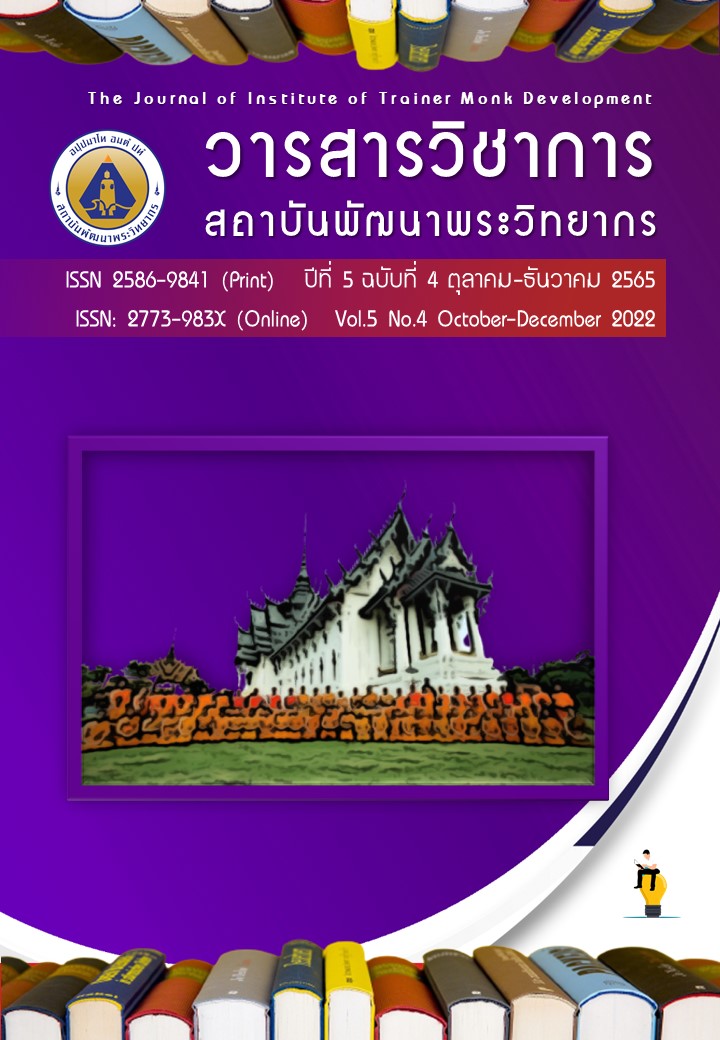A Comparative Study of Buddhist Prayer and Muslim Prayer for Peaceful Coexistence: A Case Study of the Nong-Chok Community, Bangkok
Main Article Content
Abstract
This article aimed to study to compare of Buddhist prayer and Muslim prayer for peaceful coexistence. This article is a qualitative study by studying and collecting data from religious scriptures was related to research papers and interviewing the target audiences. The research results were found as follows. There are two extreme parts of prayer is 1) The original purposes of prayer were to be instilled for study of people, and 2) As it can be generated wisdom. In Buddhists are believed that the prayer can be leading to the right path. For Muslim prayer is one of many important provisions in Islam that Muslims must obey and must be covenanted. It’s a praise of honor, supplication and asking for forgiveness from Allah. It can be seen that Buddhist prayer and Muslim prayer are continuations or connection between religions and devotees. For differentiating of both prayers are; Today Buddhists prayer really was deviated direction to be a sacred thing, and it is being holiness instead. As for the Muslim prayer, it also aims to sacrifice the love and faith onto Allah. The value and influence of Buddhist prayer and worship of the Allah’s kindness implied to show on duties of them owns the best, and they are also not interfering with other people’s duties, by this cause the principle of spreading kindness was used by Buddhists. As for Islam, it talks about taking care of others and completed understanding of others. For the different implications, it is a practice within the framework of each religion itself. The praying of Buddhists and Muslim prayer are the way of creating learning in the community by sharing in each multi religions to achieve mutual learnings. By this way is created by more mutual understanding and to create mental immunity for children since they were young. In order to learn the religious principles of their own religion by understanding, and they also need to learn other religions to be enlightened, in order to behave properly and did not interfere with other people’s beliefs.
Article Details

This work is licensed under a Creative Commons Attribution-NonCommercial-NoDerivatives 4.0 International License.
บทความที่ได้รับการตีพิมพ์เป็นลิขสิทธิ์ของวารสารวิชาการสถาบันพัฒนาพระวิทยากร
ข้อความที่ปรากฎอยู่ในบทความที่ได้รับการตีพิมพ์ในวารสาร ถือเป็นความรับผิดชอบของผู้เขียนบทความ และข้อคิดเห็นนั้นไม่ถือว่าเป็นทัศนะและความรับผิดชอบของกองบรรณาธิการวารสารวิชาการสถาบันพัฒนาพระวิทยากร
References
กิติมา อมรทัต. (2549). มุสลิมในอุดมคติ บุคลิกภาพตามแบบฉบับของอิสลามที่แท้จริงดังกำหนดไว้ในกุรอานและสุนนะฮฺ. กรุงเทพมหานคร: บริษัทมีเดียเทค.
ชมรมตับลีคประเทศไทย. (2540). คุณค่าของละหมาด. กรงเทพมหานคร: ชมรมตับลีคประเทศไทย.
ชวน เพชรแก้ว. (2520). การศึกษาวรรณคดีไทย. กรุงเทพมหานคร: โรงพิมพ์อักษรสัมพันธ์.พระครูศิริโสธรคณารักษ์. (2561). แนวทางการพัฒนาคุณภาพชีวิตตามโครงการสวดมนต์ข้ามปีของประชาชนในจังหวัดยโสธร. วารสารบัณฑิตศึกษามหาจุฬาขอนแก่น. 5(2) กรกฎาคม–ธันวาคม, 471.
พระธรรมปิฎก (ป.อ. ปยุตโต). (2546). พจนานุกรมพุทธศาสน์ ฉบับประมวลศัพท์. กรุงเทพมหานคร:มหาวิทยาลัยมหาจุฬาลงกรณราชวิทยาลัย.
พระญาณวโรดม (สนธิ์ กิจฺจกาโร). (2546). เอกเทศสวดมนต์. กรุงเทพมหานคร: โรงพิมพ์มหามกุฏราชวิทยาลัย.
พระวงศ์สรสิทธิ์ รติกโร, พระครูวิจิตรศีลาจาร. คุณค่าการสวดมนต์ที่มีต่อพุทธศาสนิกชนไทย: กรณีศึกษาสำนักปู่สวรรค์. วารสารสังคมศาสตร์และมานุษยวิทยาเชิงพุทธ. 3(2) กรกฎาคม–ธันวาคม, 79–94.
มหาจุฬาลงกรณราชวิทยาลัย. (2539). พระไตรปิฎกภาษาไทย ฉบับมหาจุฬาลงกรณราชวิทยาลัย. กรุงเทพมหานคร: โรงพิมพ์มหาจุฬาลงกรณราชวิทยาลัย.
วัดยานนาวา.(2564). สวดมนต์ข้ามปีออนไลน์ รับปีใหม่ 2564. สืบค้นเมื่อวันที่ 9 เมษายน 2565 จาก https://www. thansettakij.com/content/462557.
สำนักงานเขตหนองจอก. (2561). แผนปฏิบัติราชการประจำปี พ.ศ. 2561 สำนักงานเขตหนองจอก. ม.ป.ท.: ม.ป.พ.
อาแว วาลี. (2562). การละหมาดกับการพัฒนาคุณธรรม จริยธรรม และการเรียนรู้อย่างมีความสุขของเยาวชนมุสลิมจังหวัดนราธิวาส. วารสาร AL-NUR บัณฑิตวิทยาลัย มหาวิทยาลัยฟาฎอนี. 14(1) มกราคม-มิถุนายน, 1-14.
อัลอิศลาห สมาคมบางกอกน้อย. (2544). วิธีละหมาดตามบัญญัติอิสลาม. พิมพ์ครั้งที่ 10.กรุงเทพมหานคร: อัลอิศลาหสมาคม.


